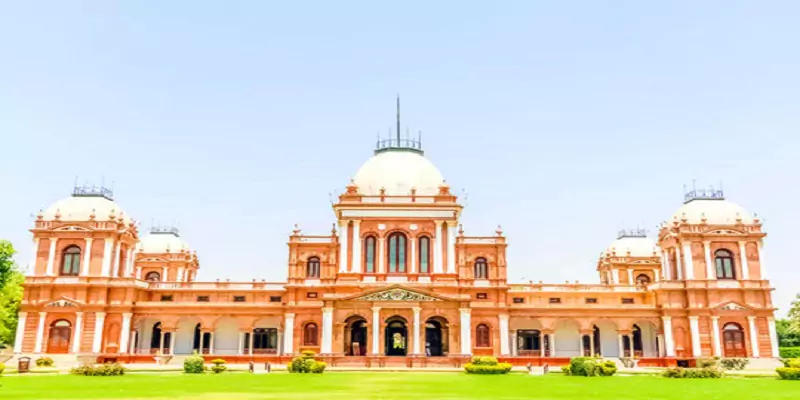Noor Mahal
Noor Mahal in Bahawalpur stands as a resplendent jewel in the architectural crown of Pakistan. This majestic palace, with its exquisite blend of European and Islamic influences, is a testament to the opulence and grandeur of the princely state of Bahawalpur. This comprehensive description will delve into the historical, architectural, and cultural aspects of Noor Mahal, offering a detailed exploration of its significance and the rich tapestry of tales it encapsulates.
The roots of Noor Mahal can be traced back to the late 19th century when Nawab Sadiq Muhammad Khan IV, the ruler of Bahawalpur, commissioned its construction. The Nawab, inspired by his frequent visits to Europe, envisioned a palace that would seamlessly amalgamate Western architectural styles with the traditional aesthetics of the region. The result is a masterpiece that stands as a symbol of the cultural synthesis prevalent during that era.
The palace, located in the heart of Bahawalpur, boasts a strategic position that affords breathtaking views of the city and its surroundings. Its imposing facade, characterized by tall towers, elegant arches, and intricately designed balconies, immediately captures the attention of visitors. The exterior is a testament to the fusion of Italian and Islamic architectural styles, creating a unique and captivating visual experience.
As one steps through the grand entrance of Noor Mahal, they are transported to an era of regal splendor. The interior of the palace is a symphony of ornate ceilings, crystal chandeliers, and polished marble floors. The European influences are evident in the grand ballrooms and reception halls, adorned with classical paintings, Victorian furniture, and luxurious tapestries. Yet, amidst the opulence, the Islamic touch is never lost, with geometric patterns and calligraphy adorning various surfaces.
The palace is divided into various wings, each serving a specific purpose during its heyday. The residential quarters, audience halls, and recreational spaces are meticulously designed to cater to the multifaceted lifestyle of the royal inhabitants. The sheer size and intricacy of Noor Mahal reflect not only the architectural brilliance of the designers but also the lavish lifestyle of the Bahawalpur rulers.
One of the standout features of Noor Mahal is its stunning Durbar Hall. This expansive hall, with its high ceiling and impressive chandeliers, was the venue for formal ceremonies and royal gatherings. The intricate craftsmanship on the walls and ceilings, coupled with the regal throne at one end, exudes an air of authority and grandiosity. It is easy to envision the Nawab and his courtiers engaged in discussions and celebrations within this magnificent space.
The palace also boasts a beautiful mosque within its premises. The mosque, with its traditional Islamic architecture, provides a serene space for prayer and reflection. The juxtaposition of the mosque alongside the European-inspired palace showcases the harmonious coexistence of diverse cultural and religious influences.
Noor Mahal's history is not devoid of intriguing anecdotes and tales. Legend has it that the palace was constructed for Nawab Sadiq Muhammad Khan IV's wife, who found the existing palaces too old-fashioned. However, due to a twist of fate, the queen spent only one night in the palace before departing, leaving Noor Mahal relatively untouched by royal occupancy. This narrative adds a layer of mystique to the already captivating ambiance of the palace.
Over the years, Noor Mahal has witnessed the ebb and flow of history. From the grandeur of the princely state to the post-independence era, the palace has stood as a silent witness to the changing tides. It has served various purposes, including hosting foreign dignitaries and serving as a state guesthouse. Despite its evolution, the palace has retained its regal charm, inviting visitors to immerse themselves in its rich heritage.
The surrounding gardens of Noor Mahal add to its allure, providing a picturesque backdrop to the already magnificent structure. The well-maintained lawns, fountains, and pathways offer a tranquil escape, inviting visitors to stroll and appreciate the architectural marvel from different vantage points. The gardens, meticulously landscaped, echo the refinement and attention to detail that characterize the palace itself.
In recent times, efforts have been made to preserve and showcase the historical significance of Noor Mahal. The palace has been opened to the public, allowing visitors to explore its corridors and chambers, marvel at its architecture, and delve into the stories embedded in its walls. The restoration work undertaken reflects a commitment to preserving the cultural heritage of Bahawalpur and providing a window into its royal past.
Noor Mahal has become not only a cultural landmark but also a symbol of Bahawalpur's resilience and commitment to preserving its heritage. The palace stands as a bridge between the past and the present, inviting both locals and tourists to connect with the regal legacy of the region. It serves as a reminder of the architectural brilliance of a bygone era and the cultural synthesis that defined the princely state of Bahawalpur.
Noor Mahal in Bahawalpur is more than a palace; it is a living testament to the grandeur, vision, and cultural diversity that characterized the princely state. Its European-inspired architecture, coupled with traditional Islamic elements, creates a captivating visual spectacle. As visitors explore its halls and gardens, they are not just witnessing history but actively participating in the preservation of a heritage that transcends time. Noor Mahal, with its tales of royalty, architectural splendor, and cultural fusion, remains a beacon of Bahawalpur's past, present, and future.

